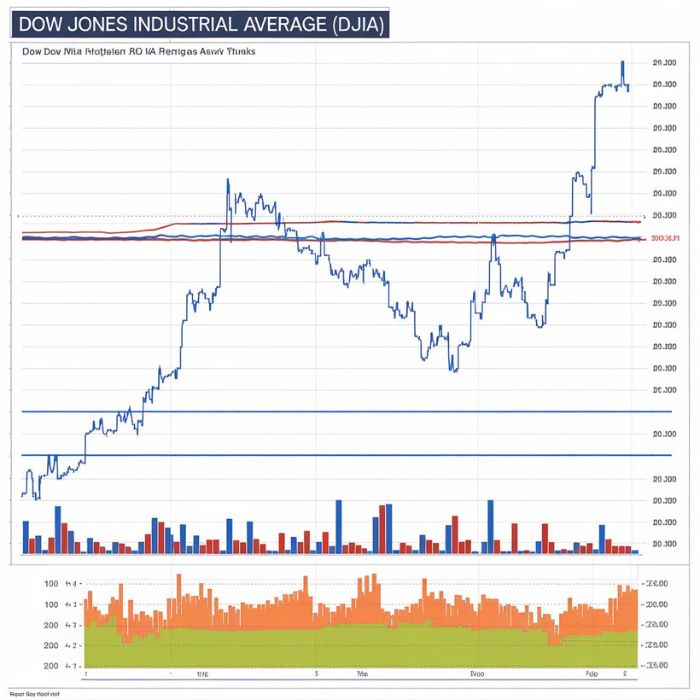Preface of the Dow Jones and its History
The stock market can often feel like a labyrinth, filled with jargon and complex charts that seem daunting to navigate. For many beginners, understanding the nuances of investing might appear overwhelming. But there’s one name that consistently rises above the rest: the Dow Jones Industrial Average (DJIA). This iconic index has been a cornerstone of financial news for over a century, serving as both a barometer for economic health and a gateway into the world of stocks.
Whether you’re intrigued by finance or simply curious about how your investments are performing, getting familiar with the Dow is crucial. What does it represent? How is it calculated? And why should you care? Let’s embark on this journey together and unravel what makes the Dow Jones such an essential part of investing in today’s ever-changing marketplace.
How the Dow Jones is Calculated
The Dow Jones Industrial Average (DJIA) is calculated using a price-weighted methodology. This means that stocks with higher prices have more influence on the index’s value than those with lower prices.
To compute the DJIA, you first total the prices of all 30 component stocks. Then, this sum is divided by a divisor. The divisor is not a fixed number; it changes to account for stock splits, dividends, and other adjustments.
This approach can create some confusion since movements in high-priced stocks can skew perceptions of overall market performance. Understanding the Dow Jones Industrial Average calculation method helps clarify why certain companies can disproportionately impact the index.
By grasping how these numbers come together, investors gain insight into broader market trends and sentiment reflected in this iconic gauge of economic health.
The Importance of the Dow Jones in the Stock Market
The Dow Jones Industrial Average (DJIA) serves as a barometer for the stock market’s health. Investors closely track its movements to gauge economic sentiment.
As one of the oldest and most recognized indices, it reflects the performance of 30 major companies across diverse sectors. When the Dow rises or falls, it often signals trends that can influence investor behavior.
Market analysts use changes in the Dow to predict future movements. A significant drop might indicate economic turmoil, while consistent gains could suggest stability and growth.
Moreover, many financial products are tied directly to this index. Exchange-traded funds (ETFs) and mutual funds frequently benchmark against the DJIA, making it a critical reference point for portfolio management.
Understanding how the Dow operates helps investors make informed decisions. It provides context within which they can evaluate their strategies in an ever-changing market landscape.
Understanding Stock Market Trends through the Dow Jones
The Dow Jones Industrial Average serves as a barometer for stock market trends. Its movements reflect broader economic conditions and investor sentiment.
When the index rises, it often signals optimism among investors. Conversely, a decline might indicate uncertainty or fear in the market. Observing these fluctuations helps traders identify potential buying or selling opportunities.
Analyzing historical data from the Dow can reveal recurring patterns and cycles. This insight allows investors to make forecasts about future performance based on past behavior.
Economic events also play a significant role in shaping trends within the index. Major news announcements, earnings reports, and geopolitical developments can all trigger sharp movements.
By tracking these shifts over time, you gain valuable perspective on how specific sectors and companies are performing relative to one another within the larger economy. Understanding these dynamics equips you with better decision-making tools when navigating your investment journey.
Investing Strategies for the Dow Jones
Investing in the Dow Jones can be an exciting journey. A strong strategy is key to navigating this iconic index.
Start with a long-term perspective. The Dow has historically shown resilience over time, making it suitable for buy-and-hold strategies. Investing consistently allows you to take advantage of dollar-cost averaging.
Consider sector rotation as another approach. Different sectors perform well under varying economic conditions. By reallocating your investments based on market trends, you can optimize returns.
Don’t overlook diversification within the Dow itself. While it consists of 30 major companies, spreading your investment across multiple industries minimizes risk and balances potential rewards.
Using options trading or ETFs tied to the Dow offers flexibility too. These instruments allow for creative investing while providing exposure without needing to purchase individual stocks directly.
Stay informed about global economic indicators as they impact market sentiments and stock performance in the index significantly.
Common Misconceptions about the Dow Jones
Many people believe the Dow Jones Industrial Average represents the entire stock market. This assumption can be misleading. The index tracks just 30 large companies, primarily from industrial sectors, leaving out many smaller or emerging firms.
Another misconception is that a rising Dow always indicates a healthy economy. While there’s often some correlation, numerous factors influence economic health beyond stock performance.
Some investors think they need to buy shares of each company in the Dow to invest effectively. In reality, various investment vehicles like ETFs and mutual funds provide exposure without overwhelming complexity.
There’s also an idea that volatility in the Dow signals impending disaster. Short-term fluctuations are normal and don’t always reflect long-term trends or stability within those companies.
Understanding these misconceptions helps sharpen your perspective on what the Dow truly signifies in today’s financial landscape.
Why Knowing about the Dow Jones is Essential for Investors
Understanding the Dow Jones is crucial for any investor. It serves as a barometer for market health, reflecting broader economic trends.
When you track the Dow, you’re not just observing numbers; you’re gaining insights into how major companies are performing. This can help inform your investment decisions and strategies.
Moreover, the Dow often influences global markets. Movements in this index can trigger reactions worldwide, impacting everything from currency valuations to commodity prices.
For those new to investing, familiarity with the Dow provides context. It helps demystify complex financial concepts and offers a clearer picture of market dynamics.
Staying informed about changes in the Dow allows investors to anticipate potential shifts in their portfolios. Recognizing patterns within this index can lead to smarter choices and increased confidence in your investments.
Final Thoughts
Understanding the Dow Jones is crucial for anyone looking to navigate the stock market. This index serves as a barometer of economic health and investor sentiment. It reflects how well major companies are performing, providing insights into broader market trends.
For beginners, grasping its history helps in appreciating its significance today. The calculation methods behind the Dow reveal much about stock value assessments. Investors often look at it as an entry point into more comprehensive financial strategies.
It’s also essential to dispel common myths surrounding the Dow Jones to foster better investing habits. A solid understanding can lead to informed decisions, aligning investment choices with overall financial goals.
As you explore investment opportunities, keep your eye on the Dow Jones. Its movements can inform you when to act and when to hold back. By staying informed about this key index, you position yourself closer to making sound investments that resonate with your objectives and risk tolerance. With all this knowledge in hand, you’re better equipped for whatever lies ahead in your investing journey.











